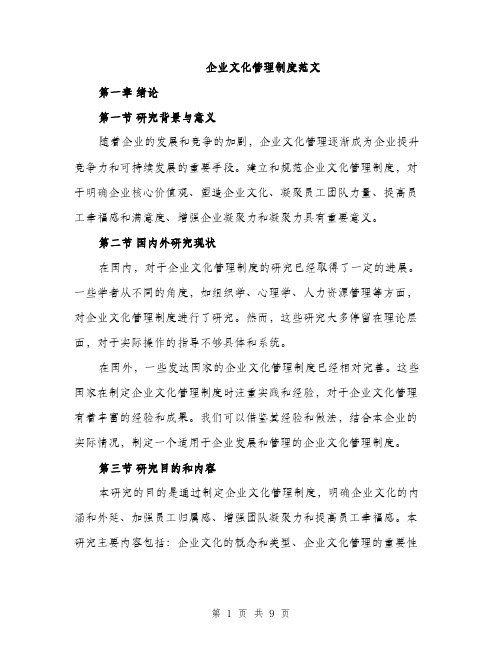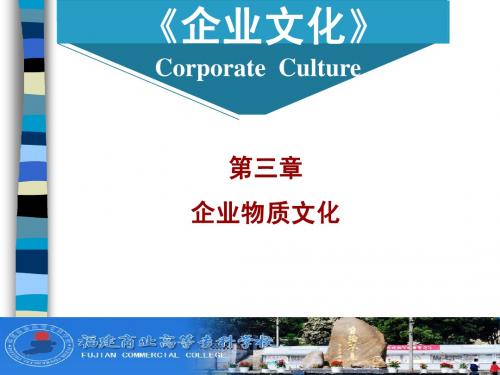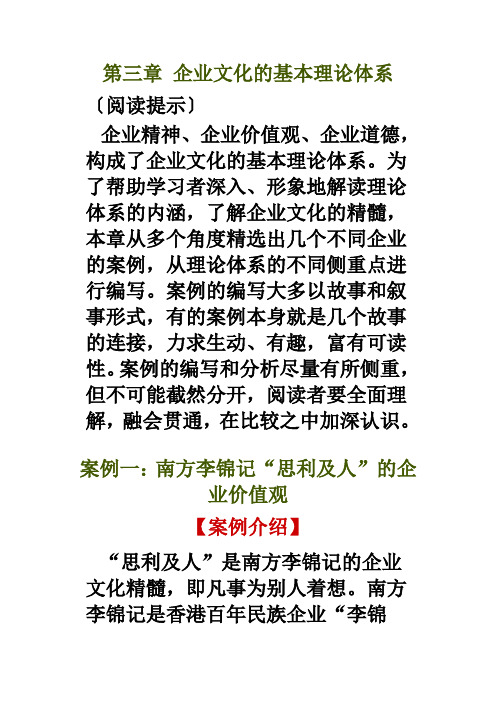第三章:企业文化
管理学3(企业文化)

(3)核心价值观 是组织长期不变的价值标准、基本信念,是组织战略 的价值内涵。
(4)组织精神
它是组织有意识提倡、培养员工群体的优良精神风貌, 是对企业现有的观念意识、传统习惯、行为方式中的积 极因素进行总结、提炼和倡导的结果。组织精神是组织 文化发展到一定阶段的产物。
(3)对组织现实文化的清晰认识,目标文化应以现实文化为 基础;
(4)对组织未来文化的科学展望,目标文化应面向未来,考 虑的是历史的走向和组织的必然发展。
文化设计中对设计者的战略眼光、哲学头脑、管理知识和 文学功底有比较严格的要求。
3、文化实施
文化实施是“依图施工”,实现由现实文化到目标文化的 过渡,实质上是组织文化的变革和更新。
又称为物质层。是组织文化在物质层次上的体现。包括组 织名称、标志、旗帜、工作服、建筑风格、纪念物、纪念 建筑等。
二、企业文化建设
所谓组织文化建设,就是组织领导者有意识地倡导优良 文化,克服不良文化的过程。
优秀的组织文化,是组织领导者有意识加以培育和长期发 展的结果。有能力的领导者选择与组织文化相一致的人作为 自己的员工,也能使与组织文化不一致的员工改变初衷,转 而与组织文化相协调。
2、重视心理强化。
所谓强化是指通过对一种行为的肯定或否定(奖励或惩 罚),从而使该行为得到重复或制止的过程。使人的行为重 复发生的为正强化;制止人的行为重复发生的为负强化。
用于组织文化建设,即及时表扬或奖励与组织文化一致的 思想和行为,及时批评或惩罚与组织文化相背离的思想和行 为。
企业文化管理制度范文(三篇)

企业文化管理制度范文第一章绪论第一节研究背景与意义随着企业的发展和竞争的加剧,企业文化管理逐渐成为企业提升竞争力和可持续发展的重要手段。
建立和规范企业文化管理制度,对于明确企业核心价值观、塑造企业文化、凝聚员工团队力量、提高员工幸福感和满意度、增强企业凝聚力和凝聚力具有重要意义。
第二节国内外研究现状在国内,对于企业文化管理制度的研究已经取得了一定的进展。
一些学者从不同的角度,如组织学、心理学、人力资源管理等方面,对企业文化管理制度进行了研究。
然而,这些研究大多停留在理论层面,对于实际操作的指导不够具体和系统。
在国外,一些发达国家的企业文化管理制度已经相对完善。
这些国家在制定企业文化管理制度时注重实践和经验,对于企业文化管理有着丰富的经验和成果。
我们可以借鉴其经验和做法,结合本企业的实际情况,制定一个适用于企业发展和管理的企业文化管理制度。
第三节研究目的和内容本研究的目的是通过制定企业文化管理制度,明确企业文化的内涵和外延、加强员工归属感、增强团队凝聚力和提高员工幸福感。
本研究主要内容包括:企业文化的概念和类型、企业文化管理的重要性和作用、企业文化管理制度的制定和实施、企业文化管理的评价和优化等。
第二章企业文化管理制度的理论基础第一节企业文化的概念和类型企业文化是指企业内部在长期运营中形成的一套共同信念、价值观、道德准则和行为准则等,体现了企业的核心价值观和行为规范。
企业文化的核心是企业的价值观和精神文化,它反映了企业的长远发展目标和愿景。
企业文化的类型主要包括:创新型企业文化、执行型企业文化、服务型企业文化和稳定型企业文化等。
不同类型的企业文化适用于不同的企业环境和发展阶段,企业应根据自身情况选择合适的文化类型。
第二节企业文化管理的重要性和作用企业文化管理是指企业针对企业文化的内涵和要求,通过一系列管理措施和手段,对企业文化进行有效引导、塑造和传播,以实现企业目标的管理活动。
企业文化管理的重要性和作用主要体现在以下几个方面:1.明确企业核心价值观。
公司企业文化日常管理制度

第一章总则第一条为加强公司企业文化建设,提升员工素质,增强企业凝聚力,形成积极向上、团结协作的企业氛围,特制定本制度。
第二条本制度适用于公司全体员工,各部门应严格执行。
第三条公司企业文化建设的指导思想是:以社会主义核心价值观为指导,传承和弘扬中华优秀传统文化,培育具有时代特征的现代企业文化。
第二章企业文化理念第四条公司企业文化理念:1. 企业使命:为客户创造价值,为员工提供平台,为社会贡献力量。
2. 企业愿景:成为行业领先、受人尊敬的企业。
3. 企业精神:团结、创新、务实、高效。
4. 企业核心价值观:诚信、敬业、共赢、共享。
第三章企业文化建设内容第五条企业文化建设内容包括:1. 树立正确的世界观、人生观、价值观,增强员工的使命感和责任感。
2. 培养良好的职业道德和职业素养,提高员工综合素质。
3. 营造积极向上、团结协作的工作氛围,增强团队凝聚力。
4. 传承和弘扬企业文化,提升企业形象。
第四章企业文化日常管理第六条公司设立企业文化管理部门,负责企业文化的日常管理工作。
第七条企业文化管理部门的主要职责:1. 制定和实施企业文化发展规划。
2. 组织开展企业文化活动,丰富员工文化生活。
3. 加强企业文化的宣传和普及,提高员工对企业文化的认同感。
4. 落实企业文化建设相关制度,确保企业文化建设的各项措施落到实处。
第八条员工应遵守以下企业文化日常管理要求:1. 爱岗敬业,勤奋工作,提高工作效率。
2. 诚实守信,公平竞争,树立良好的职业道德。
3. 团结协作,相互尊重,营造和谐的工作氛围。
4. 注重个人形象,维护企业形象,积极参与企业文化建设活动。
第五章企业文化考核与激励第九条公司将企业文化融入绩效考核体系,对员工的企业文化表现进行考核。
第十条对在企业文化方面表现突出的员工,给予表彰和奖励。
第十一条对违反企业文化规定的行为,进行批评教育,情节严重的,予以处罚。
第六章附则第十二条本制度由公司企业文化管理部门负责解释。
第三章 企业文化认知

第三章 企业文化认知
展。企业文化的开放性,必然导致外来企业文化与本土企业文化、现代企业文化与传统企业文化的交融与整合, 这也正是建设具有自身特色企业文化的契机。
(三) 可塑性 企业是一个生命有机体,企业活动是一种动态的过程。随着社会和经济的发展,各种先天性因素、历史积 累、后天营养及现实环境因素等,都会对企业文化产生影响。优秀企业文化应该适应新时代发展的要求,灵活 能动地变革,创造某些形态和模式,塑造出新的企业文化。企业文化的塑造过程,实际上也就是企业所倡导的 新的价值观念和行为方式被员工普遍认同并接受的过程。 (四) 系统性 企业文化是一个由意识形态、制度形态、物质形态等不同的层次和内容构成的相互联系、相互依赖、相互 作用有机整体。它们各有特点、相对独立,但又紧密结合。企业文化与社会文化也是一个有机的整体,社会文 化时时处处在渗透、影响和制约着企业文化的发展,而企业文化也通过其辐射功能推动着社会文化的进步,使 其成为社会文化新的生长点。可见,企业文化不是企业诸因素的简单叠加,而是相互影响、相互渗透的一个有 机系统,综合对企业管理和企业发展产生作用。
(三) 企业精神 企业精神是指企业基于自身特定的性质、任务、宗旨、时代要求和发展方向,并经过精心培养而形成的企 业成员群体的精神风貌。企业精神是企业文化的核心,在整个企业文化中起着支配的作用。企业精神通常用一 些既富有哲理,又简洁明快的语言表达,便于职工铭记在心,时刻用于激励自己;也便于对外宣传,从而在社 会上形成个性鲜明的企业形象。 (四) 企业道德 企业道德是调整本企业与其他企业之间、企业与顾客之间、企业内部职工之间关系的行为规范的总和。企 业道德与法律规范和制度规范不同,不具有那样的强制性和约束力,但具有积极的示范效应和强烈的感染力, 是约束企业和职工行为的重要手段。
企业文化传承与弘扬管理制度

企业文化传承与弘扬管理制度前言为了提高企业的凝集力和核心竞争力,构建良好的企业形象,我们订立了本规章制度,以传承和弘扬企业文化,为企业发展供应有力支撑。
第一章:企业文化基本理念第一条本企业文化制度是指对企业的思想、价值观、道德规范、行为准则的总结和提炼,是员工共同遵从的基础。
第二条本企业文化制度的基本理念是以人为本、诚信守法、创新高效、团队合作、努力探求杰出。
第二章:企业文化传承与弘扬第三条企业文化传承是指将企业文化理念转达给每一位员工,并使其真切地实践于工作与生活中。
第四条企业文化弘扬是指通过各种手段和活动,不绝巩固和提升企业文化在员工心中的地位。
第五条本企业文化制度的传承与弘扬工作由企业管理层负责,每个部门和员工也都有责任参加其中。
第三章:企业文化传承与弘扬方式第六条定期组织企业文化培训,全面介绍企业文化基本理念和相关内容,培养员工对企业文化的认同和情感。
第七条在企业内部建立企业文化宣传平台,包含企业内网、员工手册、企业文化墙等,以转达企业文化信息。
第八条提倡员工日常工作中乐观践行企业文化,鼓舞他们用实际行动诠释企业文化的精髓。
第九条组织开展各种形式的企业文化活动,如文化节、员工论坛、表扬大会等,营造浓厚的企业文化氛围。
第十条建立优秀企业文化典型人物评比活动,通过表扬先进个人,弘扬正能量,激励更多员工向优秀企业文化典型人物学习。
第十一条定期对企业文化传承与弘扬工作进行评估,收集员工看法和建议,适时进行改进和调整。
第四章:企业文化管束力和激励机制第十二条企业文化管束力是指要求员工在工作和生活中遵守企业文化,以示范行动影响和管束员工的言行。
第十三条企业将订立行为准则,明确员工在工作和生活中应遵从的道德规范和行为规范,对违反准则的行为进行相应处理。
第十四条为了激励员工乐观践行企业文化,公司将建立相应的激励机制,包含薪酬激励、晋升激励、荣誉激励等,激励员工通过实际行动弘扬企业文化。
第十五条公司将建立举报制度,鼓舞员工乐观举报违反企业文化的行为,对举报人供应相应保护和激励。
企业文化(教学课件)企业文化 第三章 企业物质文化

北京凯登公司:张力
第一节 企业文化的物质层
(4)企业起名案例
②专业特色型
无锡市水中膜技术有限公司:王希昌
我们公司的名字是很直白的,没什么意思。 膜,就是反渗透的意思,是水处理技术当中一 个非常专业的词汇。通过这个意思狭窄的名字, 突出我们公司的专业性,专业人士一看就懂, 非专业人士怎么看也不明白。
无锡万众科技有限公司 厦门量子星科技有限公司
1
第一节 企业文化的物质层
(4)企业起名案例
①寄托感情型 苏州超越自动化科技有限公司:孙扬澄
当初起名字的时候,也没有咨询什么人,自己拍着脑袋 想了五分钟,想出“超越”这个词。它代表着我的企业要 实现两个超越:一是超越客户的要求,二是超越自己。 公司的名称要能寄托自己的感情和希望。开始,我想过 用“中正”,还想到用“天和”,取开门见喜的吉祥意思。 但是很多这样动听、美丽的名字都被注册过了。凯登是 kingdom的音译,我觉得这个名字很响亮,而且,音译的名 字不容易重。它代表着我的愿望,要在自己能力范围内做 出一片天地(张力说要建造一个属于自己的商业王国 )。 1
1
第一节
企业文化的物质层
(3)如何理解企业名称的涵义
永辉超市 好又多超市 蓝天超市 超大超市 耕读茶坊 南北朝茶易居
1
(4)企业起名案例
苏州超越自动化科技有限公司
①寄托感情型 ②专业特色型
北京凯登公司
无锡市水中膜技术有限公司
北京重铭公司 ③偶然因素型 北京大丹工业设计公司
④行业背景型
⑤结合理论型
1
第一节 企业文化的物二)企业容貌
企业容貌是企业文化的表征,是体现企业
个性化的标志,它包括企业名称、企业象征 物和企业空间结构布局等。
第三章李锦记

第三章企业文化的基本理论体系〔阅读提示〕企业精神、企业价值观、企业道德,构成了企业文化的基本理论体系。
为了帮助学习者深入、形象地解读理论体系的内涵,了解企业文化的精髓,本章从多个角度精选出几个不同企业的案例,从理论体系的不同侧重点进行编写。
案例的编写大多以故事和叙事形式,有的案例本身就是几个故事的连接,力求生动、有趣,富有可读性。
案例的编写和分析尽量有所侧重,但不可能截然分开,阅读者要全面理解,融会贯通,在比较之中加深认识。
案例一:南方李锦记“思利及人”的企业价值观【案例介绍】“思利及人”是南方李锦记的企业文化精髓,即凡事为别人着想。
南方李锦记是香港百年民族企业“李锦记”与原中国人民解放军第一军医大学“联姻”的产物,1992年创业至今已有十五年。
一历史沿革李锦记第一代创始人李锦裳于1888年创建了李记蚝油庄,从此李氏家族开始了艰苦的创业历程。
第二代掌门人李兆南,为了采购原料,连续很多天吃、睡在小船上。
第三代李文达新婚就住在工厂的一间斗室,即使在艰苦的环境里,也坚持“注重诚信” 的李氏家族的追求。
凭着坚定的信念和良好的声誉,李氏家族在20世纪30年代,已将李锦记的蚝油远销欧美华人圈,初步赢得了国际声誉。
“思利及人”这四个字,来自于20世纪60年代。
当时,李文达在台湾偶遇一位专门研究字画的老人,送给他一祯珍藏多年的字幅,上书许多待人接物、理想追求的道理,有一句为“修身岂为名传世,作事唯思利及人”使他深有感触。
李文达认为“作事唯思利及人”这句话与家族的经商之道非常契合,便将“思利及人”四字单独装裱挂在办公室。
从此,“思利及人”就成为表述李锦记价值观念的核心词汇。
如今,“思利及人”的条幅同样挂在了南方李锦记董事长兼总经理李惠森办公室的墙上。
李惠森是香港百年民族企业李锦记第四代传人之一,喜欢刺激、乐于挑战是李惠森的最大特点。
由于深受父亲的影响,李惠森在做人做事中总是体现“思利及人”的理念。
“有没有打扰你?”和“有没有需要我帮忙的?”是经常挂在李惠森嘴上的口头禅。
《企业文化》教学大纲

《企业文化》教学大纲课程名称:企业文化课程类型:必修课课程学时:32学时课程目标:1.了解企业文化的概念和作用;2.分析企业文化对企业发展的影响;3.探讨企业文化的构建和塑造;4.理解企业文化与员工行为之间的关系;5.学习如何培养和传承企业文化。
教学大纲:第一章:企业文化概述(2学时)1.1企业文化的定义和特征;1.2企业文化的作用和意义;1.3企业文化与组织优势的关系。
第二章:企业文化对企业发展的影响(4学时)2.1企业文化对企业战略的影响;2.2企业文化对组织结构的影响;2.3企业文化对员工行为的影响;2.4企业文化对组织绩效的影响。
第三章:企业文化的构建和塑造(8学时)3.1企业文化的构建过程;3.2企业文化的核心价值观;3.3企业文化的传播和落地;3.4企业文化的和创新。
第四章:企业文化与员工行为(8学时)4.1员工行为的基本特点;4.2企业文化对员工行为的引导和规范;4.3企业文化对员工满意度和忠诚度的影响;4.4员工行为对企业文化的反馈。
第五章:企业文化的培养和传承(8学时)5.1企业文化的培养方法和策略;5.2企业文化的传承和发展;5.3企业文化的评价和调整;5.4企业文化的可持续发展。
教学方法:1.授课:通过讲解理论知识和案例分析,介绍企业文化的概念和作用。
2.讨论:组织学生进行小组讨论,促进学生思考和交流。
3.案例分析:通过分析具体的企业案例,寻找企业文化对企业发展的影响。
4.角色扮演:模拟企业的情境,让学生扮演不同角色,体验企业文化对员工行为的影响。
考核方式:。
企业文化与现代企业制度

• 第一节 企业文化的含义、特点和功能 • 第二节 企业文化的内容和层次结构 • 第三节 企业文业制度
1
第一节 企业文化的含义、特点和功能
一、企业文化的含义
• 社会主义的企业文化是指企业在社会主义市场经济 的实践中,逐步形成的为全体员工所认同、遵守, 带有本企业特色的价值观念,是经营准则、经营作 风、企业精神、道德规范和发展目标的总和。
9
(二)坚持商业化运营原则
• 1.建立统一、开放、竞争、有序的电力市场。 • 2.严格区分商业经营目标和非商业社会目标。 • 3.明确政府与电力企业责、权、利关系,确立电力企业经
营自主权。 • 4.完善电价形成机制。
(三)政企必须分开
10
思考题
• 企业文化的含义? • 企业文化有哪些功能? • 结合电力企业说明企业文化有哪些内容? • 简述企业文化建设的程序。 • 电力企业文化有哪些特点? • 电力企业如何实施现代企业制度?
第三章企业文化与现代企业制度第一节企业文化的含义特点和功能第二节企业文化的内容和层次结构第三节企业文化建设和电力企业文化的特点第四节现代企业制度第一节企业文化的含义特点和功能一企业文化的含义社会主义的企业文化是指企业在社会主义市场经济的实践中逐步形成的为全体员工所认同遵守带有本企业特色的价值观念是经营准则经营作风企业精神道德规范和发展目标的总和
• 企业文化具体包括以下一些主要因素:价值观、行 为准则、企业经营管理哲学、经营理念和企业精神 等,其核心内容是企业为生产经营管理而形成的观 念总和,是一种以人为中心的企业管理理论,它强 调管理中的软要素,其核心涵义是企业价值观。
2
二、企业文化的特点
• 1.企业文化是在一定环境中由企业生存发展的 需要形成的
企业文化传承与发展制度

企业文化传承与发展制度第一章总则第一条目的和依据为了加强企业文化的传承与发展,加强员工的归属感和凝集力,规范企业内部行为,提高企业核心竞争力,依据《中华人民共和国劳动法》《公司法》等相关法律法规,订立本制度。
第二条适用范围本制度适用于全部公司员工。
第二章企业文化的定义与要求第三条企业文化的定义与核心价值观1.企业文化是指企业在长期发展过程中形成的一种独特的价值观、信念和行为方式,包含企业的使命、愿景、核心价值观等。
2.公司的核心价值观是:以诚信为本、团结奋进、创新发展、努力探求杰出。
第四条企业文化的目标1.传承企业文化,弘扬核心价值观,树立企业形象。
2.培养乐观向上、团结互助、勇于创新的企业员工团队。
第五条企业文化的要求1.公司员工应乐观践行企业的核心价值观,反对任何有损企业形象和利益的行为。
2.公司员工应通过各种形式传递企业文化,加强企业凝集力和创新本领。
第三章企业文化的传承与发展第六条企业文化的传承1.公司将通过内部培训、企业文化共享会等形式,向员工宣传企业文化的核心价值观和发展历程。
2.公司鼓舞员工共享、宣传和弘扬优秀员工的典型事迹和行为,激励员工树立良好的学习、工作和生活态度。
第七条企业文化的发展1.公司将定期组织企业文化主题活动,如文化节、文艺演出等,鼓舞员工参加,提高员工对企业文化的认同和归属感。
2.公司将设立嘉奖制度,嘉奖在企业文化传承和发展中表现优秀的员工和团队。
第八条企业文化的体现1.公司要求员工在工作中遵从相关的企业文化准则和行为规范。
2.公司将订立企业文化图标、口号、企业标识等,用于外部宣传和内部呈现,体现企业文化的独特性和特色。
第四章考核与奖惩机制第九条企业文化的考核1.公司将针对企业文化的传承和发展情况进行定期考核。
2.考核内容包含员工对核心价值观的理解和践行情况、企业文化活动的参加度等。
第十条企业文化的奖惩机制1.公司将依据员工在企业文化传承和发展中的表现,予以相应的嘉奖和认可。
公司企业文化管理制度

公司企业文化管理制度第一章总则第一条为了加强公司企业文化管理,塑造具有特色的企业文化,提高员工的凝聚力和归属感,根据国家有关法律法规,结合公司实际情况,制定本制度。
第二条本制度适用于公司内部企业文化管理工作。
第三条企业文化管理的目标是:培育和践行社会主义核心价值观,弘扬中华民族优秀传统文化,塑造积极向上、团结协作、创新发展的企业文化氛围。
第四条企业文化管理工作应遵循以下原则:(一)以人为本,注重员工参与和共享;(二)创新发展,注重与时俱进;(三)系统管理,注重企业文化建设的全面性和连续性;(四)实效导向,注重企业文化建设的实际效果。
第二章组织机构与职责第五条公司设立企业文化管理部门,负责企业文化管理的日常工作。
第六条企业文化管理部门的主要职责:(一)制定企业文化发展规划和年度工作计划;(二)组织企业文化活动,推广企业文化理念;(三)负责企业文化建设项目的策划、实施和评估;(四)组织企业文化培训,提高员工对企业文化的认知和认同;(五)负责企业文化宣传,营造良好的企业文化氛围;(六)指导各部门企业文化工作,协调解决相关问题。
第三章企业文化内容第七条企业文化主要包括以下内容:(一)企业核心价值观:以人为本、诚信经营、创新发展、追求卓越;(二)企业精神:团结协作、敬业奉献、开拓创新、追求卓越;(三)企业愿景:成为行业领先、员工自豪、社会尊重的现代企业;(四)企业使命:为客户提供优质产品和服务,为员工创造发展平台,为社会承担责任;(五)企业作风:严谨务实、高效执行、精益求精;(六)企业形象:良好的社会形象、良好的行业形象、良好的员工形象。
第四章企业文化推广与传播第八条公司通过以下方式推广和传播企业文化:(一)内部培训:定期组织企业文化培训,提高员工对企业文化的认知和认同;(二)内部宣传:利用内部刊物、宣传栏、企业网站等渠道宣传企业文化;(三)外部宣传:通过参加行业活动、公益活动等方式,展示企业形象,传播企业文化;(四)企业文化活动:组织各类企业文化活动,增强员工之间的凝聚力,提升企业文化氛围;(五)企业文化建设项目:实施企业文化建设项目,推动企业文化落地生根。
企业文化建设及传承制度

企业文化建设及传承制度第一章总则第一条目的和依据为加强企业文化建设,提升企业凝集力和竞争力,规范企业员工的行为规范,保障企业的可连续发展,依据相关法律法规和公司章程的要求,订立本规章制度。
第二条适用范围本规章制度适用于公司全体员工,包含正式员工、临时员工、劳务派遣员工等。
第二章企业文化建设第三条企业文化定义企业文化是指公司内部对价值观、行为准则、职业道德等方面的共同认同和遵守,是塑造公司形象、提高员工综合素养的紧要手段。
第四条企业核心价值观公司明确了以下核心价值观:1.以客户为中心:始终以客户满意度为最高目标,供应优质产品和服务。
2.努力探求杰出:努力探求杰出的品质、技术和绩效,连续提高企业核心竞争力。
3.团队合作:鼓舞团队合作,实现共同目标,共享成绩和荣誉。
4.诚信守法:遵守法律法规,诚实守信,坚持正直、公正、透亮的原则。
第五条宣传推广公司将订立相应的宣传推广计划,通过公司内部刊物、员工培训、企业文化活动等方式,宣传和普及企业文化,加强员工的认同感和归属感。
第六条企业文化活动公司将定期组织各类企业文化活动,包含但不限于公司年会、节假日庆祝活动、团队建设等,以增长员工之间的沟通与沟通,加强团队合作,营造和谐的工作氛围。
第三章企业文化传承第七条企业文化的传承责任1.高层领导要树立文化传承的紧要性意识,乐观推动企业文化的传承工作。
2.各级管理人员要以身作则,以行动践行企业文化,成为员工传承企业文化的模范。
第八条培养员工文化意识公司将通过以下途径培养员工的企业文化意识:1.新员工培训:入职时,将对新员工进行企业文化培训,并向其介绍公司的核心价值观、行为准则、职业道德等内容。
2.员工培训:定期组织员工培训,包含但不限于企业文化内涵、企业价值观理念等方面的培训,提高员工对企业文化的认同度和理解度。
第九条文化传承评估和嘉奖制度公司将建立文化传承评估和嘉奖制度,具体包含:1.评估机制:定期对员工对企业文化的贡献进行评估,对表现出色的员工进行表扬和嘉奖。
第三章企业行政文化

第三章企业行政文化企业行政文化是企业内部的一套行为规范和价值观念,是企业内部各种行政活动的组织,协调和统一,是企业内部形成的一种共同认同和遵守的文化氛围。
企业行政文化是企业文化的重要组成部分,对企业的发展和管理起着重要作用。
企业行政文化包含了一系列的组织文化、行为准则、管理制度以及员工间的相互关系等内容,它在企业的管理决策、员工培训、组织发展等方面都有着重大影响。
企业行政文化的核心是价值观念。
企业行政文化的核心是企业的价值观念,是企业人员在工作中的价值取向和做事方式。
它是企业文化的灵魂和核心,是企业内部各种行政活动的指导方针。
企业的价值观念决定了企业的行政文化的形成,也决定了企业人员的行为和企业的发展方向。
一个企业的价值观念应该是正向的、稳定的,具有较高的道德伦理水准,能够激发员工的工作积极性和创造力,带动企业的稳定发展。
企业行政文化对企业的发展起着重要的作用。
企业行政文化对企业的发展起着重要的作用。
一个企业的行政文化应该是有利于企业发展和员工成长的,能够提升企业的竞争力和核心竞争力。
企业行政文化是企业的软实力,是企业的一种重要资源和优势。
良好的企业行政文化能够提高企业的凝聚力、向心力和团队合作能力,减少员工流失率,并增强企业的竞争力和核心竞争力。
企业行政文化对员工的行为和工作方式有着重要的规范作用。
企业行政文化是企业内部各种行政活动的组织,协调和统一,是企业人员行为的准则。
一个企业的行政文化应该能够规范员工的行为和工作方式,遵循道德伦理和法规法律等相关规定,提倡团队合作和互相尊重,营造公平、公正、公开的工作环境。
良好的企业行政文化能够激发员工的工作积极性,提高员工的工作效率和工作质量,并增强员工的归属感和忠诚度。
为了营造良好的企业行政文化,企业应该从以下几个方面入手。
首先,企业应该制定一套明确的行政文化规章制度,明确企业的行政目标和价值观念,规范企业人员的行为和工作方式。
其次,企业应该加强对员工的行政文化教育和培训,提高员工的行政文化素质,增强员工的责任心和使命感。
企业文化-企业文化塑造培训教材(PPT30页)

5. 辐射功能
企业文化形成以后,特别是在其发展到较高水平后, 不仅会对企业本身产生强烈的感染力,还会传播、辐 射到企业外部,不仅提高了企业的知名度和美誉度, 优化了企业形象,也会对社会文化的净化、改进起到 积极的推动作用。
三、企业文化的建设与培育
(一)企业文化建设的步骤
1. 企业文化盘点
第三章 企业文化塑造
第一部分 知识清单
一、企业文化含义 企业文化是指企业在长期的经营实践中形成的共同思
想、作风、价值观念和行为准则,是一种具有企业个 性的信念和行为方式,是一种企业管理经营哲学观念。
广义的文化,是指人类所创造的物质财富与精神财富 的总和。因而,广义的企业文化也就是指企业所创造 的物质财富与精神财富的总和;
企业形象的组成因素比较复杂,我们可以将其归纳为 三个层次,即理念形象、行为形象和视觉形象。
(1)企业理念形象。企业理念形象是由企业哲学、宗旨、 精神、发展目标、经营战略、道德、风气等精神因素 构成的企业形象子系统。
(2)企业行为形象。企业行为形象由企业组织及其成员 在内部和对外的生产经营管理及非生产经营性活动中 表现出来的员工素质、企业制度、行为规范等因素构 成的企业形象子系统。内部行为包括员工招聘、培训、 管理、考核、奖惩、各项管理制度、责任制度的制定 和执行、企业风俗习惯等;对外行为包括采购、销售、 广告、金融、公益等公共关系活动。
4.ห้องสมุดไป่ตู้稳定性
5. 综合性
6. 客观性
7. 时代性
8. 开放性
(二)企业文化的功能
1. 导向功能
企业文化反映广大员工共同的价值观和利益追求,对 每个员工具有强大的感召力,把每个员工的思想和行 为引导到企业的生产经营目标上,使人们自觉地为实 现企业的目标而努力工作。同时,企业本身的发展方 向也需要企业文化的引导。
CPM企业文化

第三章 CPM企业文化企业文化随管理科学的发展而产生,但又是对企业管理的超越,升华到了当代社会文化的崭新层次。
管理科学与企业文化的区别有以下三个不同。
一是遵循原则不同,管理科学以理性为工具,以“知”为目标,强调客观性,企业文化以“行”为目标,重视人的动因。
二是主体不同,管理科学以管理者为主体。
企业文化以全体员工为主体。
三是目标不同,管理科学以追求利润为目标。
企业文化以人文为目标,注重创造协调和谐的气氛,追求美好的人生。
一. 企业文化的含义企业文化指企业员工共同遵循的人生指导原则,以及在这些原则指引下的企业运作方式和员工群体生活。
企业精神是指企业的生产意识、集体意识、文明意识、竞争意识、道德意识等诸多方面汇集而成的一种群体意识的体现。
企业文化要素包括企业环境、价值观、英雄(榜样)、仪式、文化网络五项。
企业文化有以下五个方面的特征:1.时代性:企业文化受时代影响并反映时代精神。
2.人文性:企业文化按文化规律办事。
3.多样性:企业文化的外在表现形式多样化。
4.可塑性:企业文化在实践和人的能动创造中发展。
5.系统性:企业文化有相关要素的系统化。
企业文化有以下六个方面的功能:1.导向功能:引导员工为实现企业目标而自觉地努力,从直接引导员工和通过整体的价值认同来引导。
2.凝聚功能:将员工团结在一起,为一个目标而奋斗。
3.激励功能:通过员工自我价值的实现,鼓励员工不断进取。
4.约束功能:企业文化偏重于软约束,其产生的依据在于人的社会性和文化性。
5.幅射功能:通过企业与外界的交流将企业文化的内容涵昭于众并传播出去。
6.稳定功能:企业文化有助于企业在变化时维持稳定。
二. CPM企业文化主要内容多年来的物业管理实践及不断总结,形成了CPM自己特有的鲜明的企业文化。
具体体现在:企业精神:敬业、服务、创新。
敬业:就是要体现高尚的职业道德和高度的工作责任心;服务:就是深刻理解客户是我们的衣食父母。
没有我们,客户随时可以请别人管楼,而没有客户,我们公司将无法生存;创新:就是要明了物业管理行业不进则退的竞争形势,不断改进,不断探索,追求卓越。
- 1、下载文档前请自行甄别文档内容的完整性,平台不提供额外的编辑、内容补充、找答案等附加服务。
- 2、"仅部分预览"的文档,不可在线预览部分如存在完整性等问题,可反馈申请退款(可完整预览的文档不适用该条件!)。
- 3、如文档侵犯您的权益,请联系客服反馈,我们会尽快为您处理(人工客服工作时间:9:00-18:30)。
Which of the following is not implied by your text's definition of culture?
a. Culture is a perception. b. Individuals tend to describe an organization's culture in dissimilar terms. c. There is a shared aspect of culture. d. Organizational culture is a descriptive term. e. Research suggests seven dimensions to an organization's culture.
How Culture Affects(影响) Managers
establishes appropriate managerial behavior(确立合适 的管理行为) constrains decision making in all management functions(约束管理层在履行管理职能中的决策) Planning - degree of risk that plans should contain
managers are directly responsible for an organization’s success(成功) if the organization performs poorly, managers will be held accountable(经营不善,管理者负有 责任)
a common perception(共同的观点) Individuals describe organizational culture in similar terms(使用同样的术语) a descriptive term(描述性术语)
3-16
DIMENTIONS OF ORGANIZATIONAL CULTURE
EXHIBIT: DIMENTIONS OF ORGANIZATIONAL CULTURE
© Prentice Hall, 2002
3-18
Strong Versus Weak Cultures
in strong cultures, the key values are deeply held and widely shared strong cultures have greater influence on employees than do weak cultures employees more committed to organizations with strong cultures
Reality Suggests a Synthesis
managers are neither helpless nor all powerful
管理者自由度的悖论 Paradox of Managerial Discretion
管理自由度 企业文化
Organizational Culture
3-21
How Employees LearnCulture
Stories(故事) - a narrative of significant events or people Rituals(象征) - repetitive sequences of activities Material symbols(有形标识) – essential in creating an organization’s personality. Language(语言) - identifies members of a culture organizations develop unique terminology or jargon
Stakeholder partnerships Boundary spanning Stakeholder management Scanning and monitoring the environment
The Role of Manager?
Omnipotent View of Management
Managerial Discretion
经营环境
Organization’s Environment
3-15
What is Organizational Culture?
A system of shared meaning and beliefs held by organizational members that determines, in large degree, how they act (behave)
3-13
Symbolic View of Management
the actual part that managers play in organizational success or failure is minimal managers must create meaning out of randomness, confusion, and ambiguity
第三章:企业文化
ORGANIZATIONRAINTS
Learning Objectives
Differentiate the symbolic from the omnipotent view of management Define organizational culture Identify the seven dimensions(标准 与尺度) that make up(构成) an organization’s culture and how these dimensions reflect the organization’s personality
The Source of Culture
usually reflects the vision or mission of the founder founders project image of what the organization should be
© Prentice Hall, 2002
© Prentice Hall, 2002 3-19
strong cultures are associated with (相联系) high organizational performance(业绩) most organizations have moderate (适中) to strong cultures
3-2
Explain how cultures can be strong (强力) or weak(形式) Describe the various ways that employees learn culture Explain how culture constrains(约束) managers Describe the various components in an organization’s specific and general environments
The link between organizational values and managerial behavior is ______.
a. uncertain b. fairly straightforward c. loose and difficult to see d. unimportant e. hidden
Organizations in which the key values are intensely held and widely shared have _________ cultures.
a. b. c. d. e. emerging aggressive weak strong assertive
What is the original source of an organization's culture?
a. The organization's industry b. The organization's size c. The organization's age d. The organization's geographic location e. The organization's founder
3-4
思考题
Mary has also been asked, as part of the cultural change, to build on the belief that managers are directly responsible for the organization's success or failure. This would be consistent with an organizational culture that has a (n) ______ view of management.
organizational culture may be derived from seven dimensions
Outcome Orientation People Orientation Team Orientation Attention to Detail Innovation and Risk-taking Stability Aggressive L/H L/H L/H L/H L/H L/H L/H
Learning Objectives (cont.)
